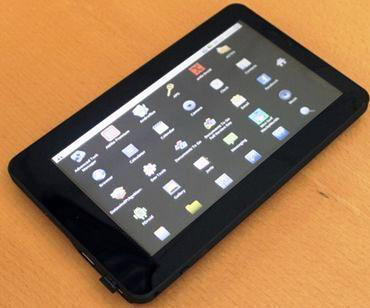
Pranab Mukherjee, the prime minister of India, showcased the 7-inch Aakash 2 tablet computer on November 11 which the government of his country will be purchasing for 100,000 university students and professors. The tablet is a product of an Indian/UK/Canadian startup named Datawind run by a 44-year old CEO, Suneet Tuli. If the first batch that is sent out is met with a good response, the company could end up getting an order for 5.86 million pieces.
Tuli states that his company has been hit hard by requests for the tablet and Datawind already has a backlog of four million for the commercial version of the device. All the interest in the 7-inch tablet stems from the fact that it is extremely cost effective. The version that students in India will receive is only $20 after the government of India subsidizes half the cost. Chinese manufacturers sell similar tablets for $45 or more at wholesale prices. This means that right now the Aakash 2 is the cheapest fully functional tablet PC in the world.
The low price of the device is a major selling point for developing regions like India. The South Asian country has one billion people that make less than $200 per month and purchasing a conventional computer is out of the question, leaving the government with ambitious plans of distributing the table to 220 million students. On the commercial end, the Aakash 2 also has a lot of potential in the country because 95% of Indians have no computing device. A low cost tablet could cover the gap in India and other nations.
Aakash 2 is light years ahead of its predecessor the Aakash 1 which failed because it was underpowered and could not handle normal functions. The latest tablet is a lot more useful and runs Google’s Android mobile operating system on a processor that is comparable to the first iPad and has two times the RAM of Apple’s first tablet. The device also has a LCD touch screen which has full-screen video, has smooth internet browsing, can play mobile video games and with a keyboard it can run like a PC.
This is the killer combo that could make low priced tablets like the Aakash 2 a game changer the world over. Vivek Wadhwa, an entrepreneur and academic, states that, “The revolution will come from the developing world to the US. These tablets will kill the markets for high-end players—for Microsoft in particular.” He is promoting the Aakash 2 in the US and says that the tablet will drop to $25 from $40 within one year. Wadhwa claims that, “I showed a Google executive [this] tablet. He suddenly realized that his $99 tablet isn’t going to stand up to the $25 tablet from India.”
Developed markets may soon feel the impact of the upcoming wave of low cost tablets. Financial analyst Jay Goldberg says, “I see a lot of the PC makers and hardware companies here [in the US] are going to build a tablet strategy. But if there are already $45 tablets out there, even that second-tier strategy [of replacing lost PC sales with tablets] is going to fail.”
However, the focus for now is not the developed world but the developing world. Tuli states that, “Our effort in all of this was to use technology to fight poverty. What happens when you try to make it affordable at this level?” One way to fight poverty is to replace textbooks with ebooks. This will save the Indian government money because the country spends almost $13 per student per year on shipping books to students. The government is thinking about paying the complete $40 for the tablet because it can now make up the price within three years.
The true power of the tablet is not just about cutting cost or replacing textbooks but bringing the internet into households that have never used it. The competitive wireless sector offers customers the chance to get unlimited prepaid mobile data plans for nearly $2 a month. For users that buy the $70 version of the Aakash 2 with SIM cards and radio can utilize the cellphone network for internet.
As prices fall, tablets will become part of life in countries like the US. Wadha states that, “[In the US,] you will see tablets everywhere. They will become disposable, and you will see thousands of new applications within a short period of time.” That’s why new applications will start to appear that will utilize disposable tablets and change the way people live. For example, restaurants will take orders from tablets which will connect to the main cash register and kitchen. Or households will have tablets to control building functions including temperature and security.
In the end, it seems that the poor will lead the world in the tablet revolution. They may end up adopting the technology a lot quicker, akin to how cell phones have replaced land lines in developing countries. Instead of buying a full PC, they might just skip this step and head straight for the tablet.
Source: Quartz
Photo: DataWind
Magnificent beat ! I would like to apprentice at the same time as you amend your website, how can i subscribe for a blog web site? The account helped me a acceptable deal. I were a little bit acquainted of this your broadcast offered shiny transparent idea